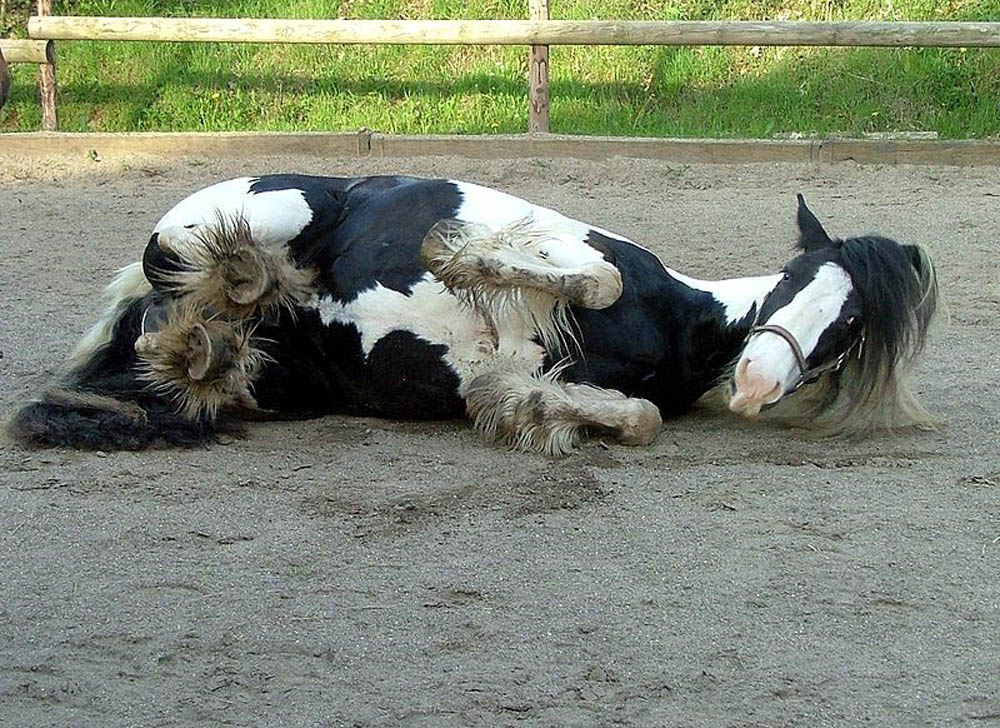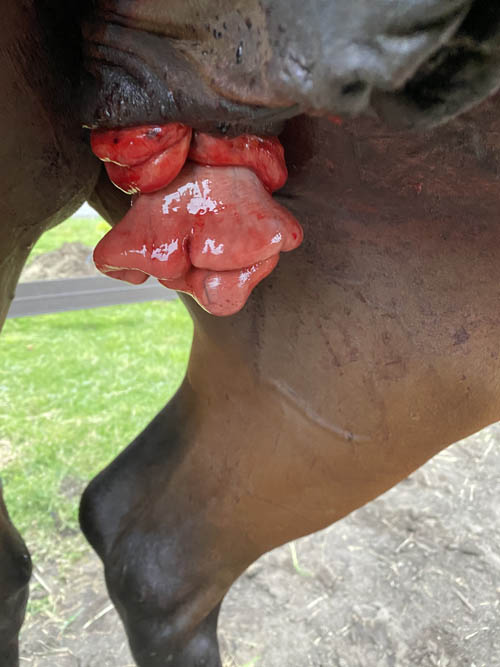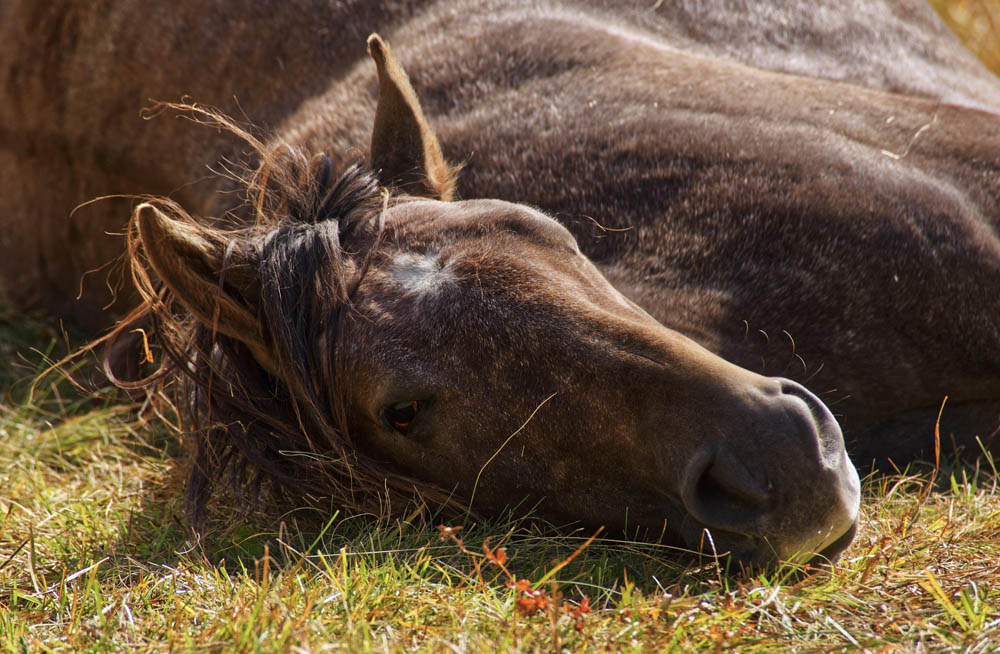A vet’s life is seldom boring and quite often we find ourselves running from one job to another trying to cope with the simultaneous arrival of multiple “emergency calls” into our diary.

In situations like this, we have no choice but to prioritise what is a true life and death emergency, what is urgent but can wait for an hour if necessary, and what is urgent in the eyes of an owner but isn’t going to result in the death of a horse if not seen immediately.
It can be very difficult to explain to an owner that what they perceive as life-threatening isn’t what as a vet I would perceive as life-threatening, or that another horse must take priority over their beloved horse. For this reason, it is vital that the owner learns to communicate to the veterinarian or their staff an objective assessment of what the horse is doing, or suffering with, rather than using a subjective emotional description of the problem.
Often if an accurate description of the problem can be portrayed to the vet, he or she can not only prioritise when the horse needs to be attended to, but also issue practical and safe first aid options to the owner and help alleviate some of the owner’s worries.
Obviously, I can’t list all the life-threatening emergencies that dictate immediate veterinary intervention, but here are a few scenarios that are prioritised as No. 1 concerns:
MARE DYSTOCIA (DIFFICULT FOALING)
Mares have a short, intense delivery phase once their waters have broken and generally will deliver the foal within 40 minutes, often sooner. If the foal is not delivered within this time, the rate of survival of the foal diminishes significantly and the risk of significant damage or death to the mare increases greatly. Early veterinary intervention is paramount if the foal is to survive, especially if the foal has already entered the vaginal canal and is prevented from being expelled either due to malpositioning, size or deformity of the foal, or the mare’s inability to push the foal out.
The difficulty for veterinarians is differentiating a dystocia from a mare in first stage labour based on a phone call from a frantic owner. There have been multiple times I have been called to a foaling in the middle of the night, only to be turned around on the drive there because the foal has been delivered safe and well with minimal intervention by the owner. This is because owners can confuse the first stage of labour with the delivery phase. In first stage labour, the mare is restless and has small contractions as the foal positions itself for the impending delivery, and this phase can go on for several hours.
Careful questioning of the owner can often help the vet decide if the mare is in trouble or not, but this relies on the owner being observant and, more importantly, not panicked by the scenario and able to relay relevant information such as the duration the mare has been agitated, if the membranes or any part of the foal has been seen through the vulval lips or if the mare’s water has broken.
Often maiden mares will have a protracted first stage labour as anxious owners fuss around them, and in these cases the best advice is to leave the mare on her own for 10 minutes and then check on her to see if she has foaled. Usually in these cases, I will proceed on the assumption that the mare is having difficulty and if so, I’m already on my way – but if she foals in the meantime, everybody is happy. For this reason, it is also very important that if the mare foals and you have called the vet to assist, that you contact them immediately, even if you still would like the vet to visit, in case the vet has another emergency on the go – or as has happened to me before, racing to get to your foaling and copped a speeding fine on the way!
SNAKEBITE
Although not always visualised, if there is evidence your horse has been bitten by a snake – such as seeing the horse bitten or a sudden head movement up in the presence of a snake – then this can be a life and death emergency and veterinary attention should be sought immediately. In areas where snake numbers are high, or an increased level of snake activity has been detected, and the horse begins to show evidence of snakebite poisoning, this constitutes an emergency warranting immediate attention.
Signs of snakebite include muscle tremors, unsteady movements, frequently up and down, pupil dilation, sweating and laboured breathing, and can often be mistaken by owners as having colic. Sometimes swelling may develop around the muzzle and occasionally small fang marks may be visible, but this is probably the exception and not the rule. If the owner has been able to identify the snake that has bitten the horse or has a sound knowledge of the most prevalent snakes in the area, then this is worth passing onto the vet.

EVISCERATION
This is predominantly seen following a recent castration but can technically occur through an abdominal laceration. Evisceration is the protrusion of the abdominal contents through an open wound or castration site into the environment. It constitutes as a life or death emergency and veterinary assistance should be sought urgently. The most immediate threat is the contamination or the damage of the contents, and it is vital to do whatever is necessary to prevent the abdominal contents from contacting the ground – or worse, being stood on by the horse as this almost certainly warrants immediate euthanasia.
Unfortunately, one of the factors that adds to the need for immediate veterinary intervention is that the weight of the intestines passing through the wound acts as a catalyst and causes more of the intestinal bowel to follow, which further increases the rate of evisceration. I was called to a colt that jumped a fence and opened his scrotum into the abdomen, and by the time I arrived 30 minutes later, the entire gut contents were outside the body, and I couldn’t euthanise him quick enough to stop the suffering.

My advice to anyone whose horse experiences the early stages of an evisceration is to get a large clean sheet, wet it and use it as a sling to hold the intestines up, reducing the weight effect that is pulling more intestine out. Easier said than done, I realise; however, it is better to be proactive and make an attempt to slow the progress down than to do nothing except watch the amount of exposed intestines continually increase while waiting for the vet to arrive. If a vet is not available to attend quickly and an equine hospital or clinic that can perform surgery is within an hour or so of the property, I would recommend the horse is put onto a float and taken there immediately as time is crucial.

COLIC
Horses with colic are a common event and many colicky horses are not what I would call life or death emergencies, however, there are some colics that require urgent treatment, and this can be difficult to decide over the phone. Horses with unrelenting pain that are unable to be walked without throwing themselves on the ground need to be seen ASAP. Horses that are uncomfortable but can be walked to relieve the pain can generally wait an hour or so until they are seen if necessary.
There are two main reasons why horses that continually throw themselves down or won’t walk comfortably need to be seen immediately if possible. The first is that acute abdominal catastrophes such as a twisted large bowel are incredibly painful, and a horse can rupture its intestine and die within hours of the torsion occurring. These horses need to be assessed and referred to a surgical hospital if they are to have any chance of survival. Not all horses that show unrelenting severe pain require surgery, however, most horses that require surgery show unrelenting pain. The second reason is that horses can injure themselves quite easily when they have severe colic pain and will smash their head against surfaces, causing damage around the eyes and poll. It is debatable whether rolling can induce further injury in the abdomen, and allowing a horse to roll when colicky was often blamed for the horse twisting its bowel. However, it is equally as likely that horses with a twisted bowel roll because of the twist, rather than cause the twist by rolling.
CATASTROPHIC LIMB FRACTURES
These are injuries that are not amendable to fracture repair and require euthanasia on humane grounds. Traditionally, displaced fractures above the knee or hock have been poor candidates for surgery and although attempted many times, the success rate is dismal. Horses also respond very poorly to infections within the medulla of the bone and therefore compound bone fractures (where the bone has gone through the skin) carry an extremely poor prognosis and necessitate immediate euthanasia. Therefore, if bone is seen protruding or if there is severe deviation of the limb indicating a displaced fracture, the vet should see the horse immediately.
In cases where there is some displacement of the fracture below the knee or hock (so the cannon or pastern bone is fractured) but there is no external wound, these can be successfully repaired, and also need to be seen by a vet immediately as the fracture requires stabilisation to prevent the fragmented bone piercing the skin, changing the outcome from repair to euthanasia.
In situations where a fracture is suspected by the owner, but there is no visible sign of swelling or displacement, these are not a No. 1 priority as they can be boxed or prevented from moving for several hours without affecting the outcome. If there is swelling that alerts the owner to the site of a potential fracture, a firm bandage can be applied to the limb, incorporating the joint below the area and the joint above the area, to stabilise it. For example, if there is some swelling above the fetlock and the horse is fracture lame, a firm bandage can be applied from the pastern to the knee.
SEVERE TRAUMA
Most traumas with horses are centred around their legs and causing large lacerations that need to be dealt with in a timely fashion but are not necessarily a No. 1 priority. This is because many leg injuries can be dealt with by their owners using basic first aid until the vet can arrive. First aid usually involves cleaning off any major contamination to the wound, applying pressure to stop bleeding and applying a bandage to keep the area from swelling and the tissues from drying out. This may not always be possible, particularly in unhandled horses, but, if possible, they can be moved to a quiet, cleaner environment and left until the vet can arrive.
However, there are traumas that warrant immediate attention, and these would include severe head traumas, especially those where the horse is thrashing on the ground and cannot be settled by gentle words or a towel over the eyes. Any injury where there is uncontrollable blood flow has the potential to be life-threatening and, in these situations, it is vital that there is good, clear, and concise communication between the owner and the vet. A wound that is dripping blood is unlikely to result in death, so if you can count the drops it is less of a concern than a wound where the blood is a steady stream. If possible, firm pressure can be applied to these wounds to slow the flow and encourage the blood vessels to close will help immensely until the vet arrives – but once again, communicating an accurate picture to the vet will allow them to issue some helpful tips.

RECUMBENT FOALS
Whilst sick foals are not always as urgent a priority as some of the emergencies listed above, they can succumb to infection, hyperthermia (low body temperature), dehydration and hyperglycaemia (low blood sugar) very quickly and are thus worthy of a mention here. Neonatal foals (0-7 days old) are particularly vulnerable, as they have no energy stores in their body and very little body fat to keep them warm. If they go off the suck for a variety of reasons, including maladjustment syndrome, septicaemia or diarrhoea, the foal rapidly deteriorates and can die within hours. A sick foal should be seen as soon as possible by a veterinarian but can wait an hour or two until the vet is available.
However, if the foal is found recumbent and non-responsive to stimulation, it requires urgent veterinary attention and should be prioritised as a number one concern. These foals require intravenous fluids and glucose as soon as possible if they are to have any chance at survival. The foal should be kept in a warm, clean environment until the vet arrives, especially if the weather is poor, and in cases where the foal is recumbent, then blankets should be used to help maintain body temperature and reduce further heat lose.
Similarly, if the foal is recumbent in a paddock on a hot day, every attempt should be made to provide some protection from the sun to reduce the rate of dehydration that will occur if left exposed to the heat. This includes bringing the mare and foal into a stable (a wheelbarrow can be used to transport the foal if necessary) or setting up some form of shade over the foal until the vet arrives.
It is very difficult to list every scenario that could be described as a true “life or death” situation requiring priority treatment. There are incidents such as badly lacerated eyes or acute diarrhoea that are time-sensitive and should be seen as quickly as possible, but I have not included them in the above list as I would not prioritise them over the cases listed above. If, however, you are really concerned about your horse and your vet is attending another emergency and cannot get to your horse immediately, you may prefer to contact another vet in your area or transport your horse to a veterinary clinic if one is nearby and the horse is able to travel.
Remember when seeking veterinary attention to be as objective about the emergency as you can, include photos from your phone if possible, and let the vet help you deal with the situation in a way that gives the best outcome for the horse. EQ
YOU MIGHT ALSO LIKE TO READ THE FOLLOWING BY DR MAXINE BRAIN:
Peri-Tarsal Cellulitis Calls for Quick Action – Equestrian Life, June, 2022
Sinusitis: Not To Be Sneezed At – Equestrian Life, May, 2022
Japanese Encephalitis: No Cause For Alarm – Equestrian Life, April, 2022
Hernia Learning Curve – Equestrian Life, March, 2022
Osteochondromas: Benign But Irritating – Equestrian Life, February, 2022
Don’t Forget the Water – Equestrian Life, January, 2022
Understanding Anaesthesia – Equestrian Life, December, 2021
A Quick Guide to Castration – Equestrian Life, November, 2021
Caring for Mammary Glands – Equestrian Life, October, 2021
Sepsis In Foals – Equestrian Life, September 2021
Understanding Tendon Sheath Inflammation – Equestrian Life, August 2021
The Mystery of Equine Shivers – Equestrian Life, July 2021
Heads up for the Big Chill – Equestrian Life, June 2021
The Ridden Horse Pain Ethogram – Equestrian Life, May 2021
The Benefits of Genetic Testing – Equestrian Life, April 2021
Heavy Metal Toxicities – Equestrian Life, March 2021
Euthanasia, the Toughest Decision – Equestrian Life, February 2021
How to Beat Heat Stress – Equestrian Life, January 2021
Medicinal Cannabis for Horses – Equestrian Life, December 2020
Foal Diarrhoea Part 2: Infectious Diarrhoea – Equestrian Life, November 2020
Foal Diarrhoea (Don’t Panic!) – Equestrian Life, October 2020
Urticaria Calls For Detective Work – Equestrian Life, September 2020
Winter’s Scourge, The Foot Abscess – Equestrian Life, August 2020
Core Strengthening & Balance Exercises – Equestrian Life, July 2020
The Principles of Rehabilitation – Equestrian Life, June 2020
When is Old, Too Old? – Equestrian Life, May 2020

